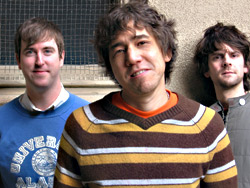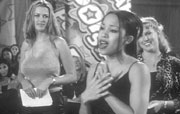“And you won’t be much/But you’ll miss my touch completely,” sings the Can’t See’s John Atkins on the band’s debut. But to whom? You’re never sure. On Coma Comma No More‘s next track, Atkins tosses off another second-person accusation/affirmation: “And you hate that you sound like the end of a bar fight/All cursed and slurred.” The piano line comes and goes because too much melancholy is just too much. The beat shuffles, slowly, and the guitar sound mimics the gravel under overtaxed tires. The point of view shift works; you start thinking that you do really hate it when you sound all cursed and slurred, and that too much melancholy is just too much.
“I say ‘you,’ and I might mean whiskey; I say ‘I,’ and I might be talking about myself as a kid or something,” Atkins tells me. “I’ve got a pronoun problem.”
It’s a nice problem to have, however, because it helps serve the band’s goal. The Can’t See started with Atkins asking his friends for some help recording a few songs, but once the singer/guitar player, drummer Thomas Wright, and keyboard/piano player Ken Jarvey figured out they were indeed a band and not a glorified solo project, they decided their band should be genreless. Generalist.
Familiar to many in town because of their former bands—764-HERO and Magic Magicians, Exbestfriends, and Aveo and New Luck Toy, respectively—the trio didn’t want to make indie-rock songs. They didn’t want to sound like Seattle, like 2006, like ex-members of their ex-bands. And Atkins didn’t particularly want to tell his own stories. So, instead, he’s lobbing them over to you. “You do what you can/You do what you will,” he sings on “You Do What You Can,” sounding not unlike Sunny Day Real Estate’s Jeremy Enigk.
Not that the Can’t See sound like Sunny Day. At least not any more than they sound like vintage Kinks, that first really brilliant and complex Destroyer record, or the secret tapes of Crosby, Stills, Nash & Young collaborating with Belle & Sebastian.
Adding to the agreeably ambiguous and universal tone of the songs on Coma Comma is a little trick involving sequencing and song titles—the title track’s “reprise” comes first, and a two-minute “intro” comes fifth—and an anything-goes attitude toward instrumentation. “Coma, No More” features the drummer taking turns on lap steel guitar and Wurlitzer piano, while Jarvey yields the fiddle. On “Sad Version,” Jarvey plays the accordion; on “You Do What You Can,” he picks up the clarinet; on an extra track set to appear on the Japanese version of the album, he plays xylophone, saxophone, and synthesizer. Despite this deft apparatus juggling, it’s the consistency of his ductile, comfortable piano-y keyboards that lends the Can’t See their greatest sense of Sound. (Atkins’ midnight phone-booth vocals—as in, they’re all so urgent and immediate—and tart turns of phrase, along with Wright’s restrained but artful rhythms, are close seconds.)
Of the game plan in the studio, Jarvey says it was: “Anyone grabs the next instrument they think will fit and records it.” Everyone pitched in percussive elements, Wright took turns with keys and bass, and Atkins tracked extra vocal and guitar lines. With lawlessness encouraged and instrument swapping rampant, the songs might have suffered from multiple personality disorder. Pop doesn’t always respond well when there are lots of cooks in the kitchen. Credit the trio’s friendship—long, deep, and based in that very same pop song—with achieving a balance. Then credit the friendship again for figuring out how to make live reproductions of the leaping, textural sounds of multitracked recordings with just six hands. Jarvey’s keys, warmed through a tube amp, fill up the bottom end, Wright’s drumming is almost melodic, and both players back up Atkins with soft, twisted harmonies, sharp yelps, and quickly cut corners. They even figured out how to replicate some of the studio’s random energy; all three agree that the band allows for an element of live improvisation that none has experienced in previous projects.
OF COURSE, if a person—or three—wanted to distance himself from the here and now, the first few things out the door would be digital. And of course, that person would have to deal with being associated with everyone else who rejects the ease of MP3s and burned CDs, but then most of life comes down to choosing between two evils. Early on, the Can’t See identified vinyl as their medium (anyone can burn a CD; you have to really want to make a record), and they identified themselves as ones who should put the vinyl out. “It means more,” says Atkins, of their finished product and the truly DIY self-release, “but also, I never want to have to do it this way again.”
But then, if a person—or three—wants gas to fuel the van, he’d better have something to sell in the merch booth. Before leaving for their first tour this past winter, the Can’t See went ahead and burned some CDs and slid them inside the LPs’ plastic sleeves. This way, everyone wins.








